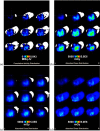Direct intratumoral infusion of liposome encapsulated rhenium radionuclides for cancer therapy: effects of nonuniform intratumoral dose distribution
- PMID: 21520844
- PMCID: PMC3055907
- DOI: 10.1118/1.3552923
Direct intratumoral infusion of liposome encapsulated rhenium radionuclides for cancer therapy: effects of nonuniform intratumoral dose distribution
Abstract
Purpose: Focused radiation therapy by direct intratumoral infusion of lipid nanoparticle (liposome)-carried beta-emitting radionuclides has shown promising results in animal model studies; however, little is known about the impact the intratumoral liposomal radionuclide distribution may have on tumor control. The primary objective of this work was to investigate the effects the intratumoral absorbed dose distributions from this cancer therapy modality have on tumor control and treatment planning by combining dosimetric and radiobiological modeling with in vivo imaging data.
Methods: 99mTc-encapsulated liposomes were intratumorally infused with a single injection location to human head and neck squamous cell carcinoma xenografts in nude rats. High resolution in vivo planar imaging was performed at various time points for quantifying intratumoral retention following infusion. The intratumoral liposomal radioactivity distribution was obtained from 1 mm resolution pinhole collimator SPECT imaging coregistered with CT imaging of excised tumors at 20 h postinfusion. Coregistered images were used for intratumoral dosimetric and radiobiological modeling at a voxel level following extrapolation to the therapeutic analogs, 186Re/ 18Re liposomes. Effective uniform dose (EUD) and tumor control probability (TCP) were used to assess therapy effectiveness and possible methods of improving upon tumor control with this radiation therapy modality.
Results: Dosimetric analysis showed that average tumor absorbed doses of 8.6 Gy/MBq (318.2 Gy/mCi) and 5.7 Gy/MBq (209.1 Gy/mCi) could be delivered with this protocol of radiation delivery for 186Re/188Re liposomes, respectively, and 37-92 MBq (1-2.5 mCi)/g tumor administered activity; however, large intratumoral absorbed dose heterogeneity, as seen in dose-volume histograms, resulted in insignificant values of EUD and TCP for achieving tumor control. It is indicated that the use of liposomes encapsulating radionuclides with higher energy beta emissions, dose escalation through increased specific activity, and increasing the number of direct tumor infusion sites improve tumor control. For larger tumors, the use of multiple infusion locations was modeled to be much more efficient, in terms of activity usage, at improving EUD and TCP to achieve a tumoricidal effect.
Conclusions: Direct intratumoral infusion of beta-emitting radionuclide encapsulated liposomes shows promise for cancer therapy by achieving large focally delivered tumor doses. However, the results of this work also indicate that average tumor dose may underestimate tumoricidal effect due to substantial heterogeneity in intratumoral liposomal radionuclide distributions. The resulting intratumoral distribution of liposomes following infusion should be taken into account in treatment planning and evaluation in a clinical setting for an optimal cancer therapy.
Figures


References
-
- Prestwich W. V., Nunes J., and Kwok C. S., “Beta dose point kernels for radionuclides of potential use in radioimmunotherapy,” J. Nucl. Med. JNMEAQ 30, 1036–1046 (1989). - PubMed
-
- Goldenberg D. M., “Targeted therapy of cancer with radiolabeled antibodies,” J. Nucl. Med. JNMEAQ 43, 693–713 (2002). - PubMed
Publication types
MeSH terms
Substances
Grants and funding
LinkOut - more resources
Full Text Sources
Other Literature Sources
Medical

